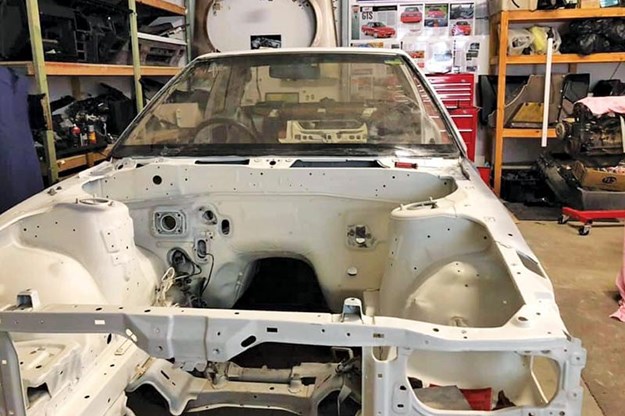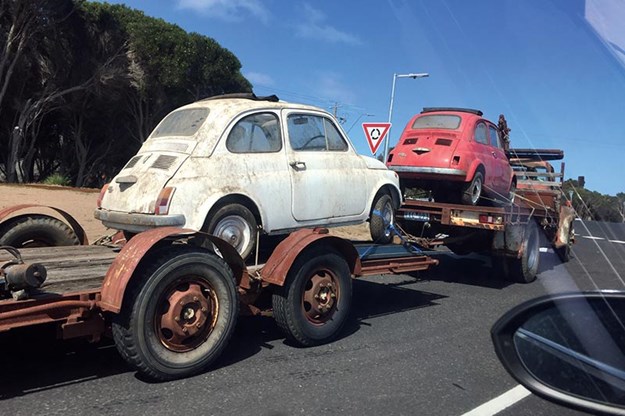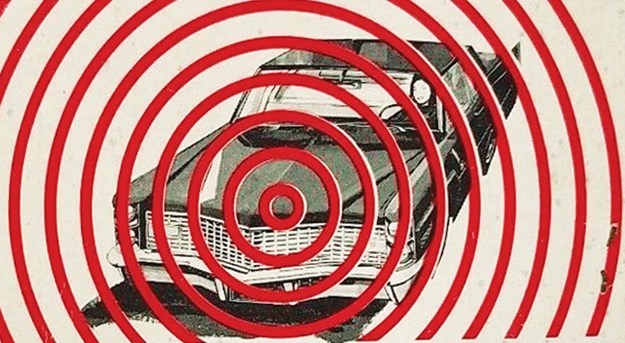Your projects and tech talk - Mick's Workshop 446



|
Nissan and FJ4 restos, Bambino love, hoists, Thunderbirds and much more...
Mick's Workshop
I had reason to chew over the whole theme of doing a project car recently and reckon there are a couple of areas where people most commonly fall over – the start and the finish. Now this isn’t meant to put you off!
At the start, I reckon one of the best tips is to be properly-equipped, and that means having a hoist. Let’s face it, we can easily spend $20-30-50-plus kay on a project and, to me, it makes a whole lot of sense to spend the first few on a hoist.
Yep, we’ve covered this before, but it’s worth repeating. A good four-poster from a local mob like Tufflift is ideal for working from home. I like four-posters because they’re ultra-stable and safe, plus you can open the car doors while you’re working on it.
I reckon hoists are a major back-saver, too. You can position the car exactly where you need it, so you’re not having to pretend you’re a combination of mechanic and contortionist.
As for finishing off, I do a lot of tidying-up work on other people’s projects. Don’t get me wrong – I love it. Often it’s just the car needs the tuning wand waved over it to get it running right. Sometimes it’s a little more involved.
A good example is a Thunderbird I have in the shop at the moment. It’s a lovely job and the owner should be proud. However the thing wouldn’t run right. All the usual culprits checked out and it even had a new fuel pump. But the tank? It needed to be pulled and flushed out and then everything was fine.
While you’re at it, have you changed all the fuel hoses? And I mean all of them. That, I reckon, is probably the biggest cause of fires in old cars. Just one of those finishing touches.
By the way, we’ve had a bunch of people send in pics and a bit of info on the cars they’re working on, via email (uniquecars@primecreative.com.au) and Facebook. Great stuff – keep them coming!
HERE'S MY TIP:
Sweet Sounds

If you’re thinking of updating the sound system in your old jalopy, consider putting the original head unit away in the boot or the shed, even if it’s not working! One day, a future owner/restorer will be delighted to know it’s still there.
LETTERS:
Nissan Workshop

Some assembly required, battery not included
I’m in the process of restoring a few Nissans, including this one, an HR31 Skyline GTS-X coupe. My plan is to turn it into a two-door version of the Aussie-built SVD R31 Silhouette GTS2. What do you reckon?
Duncan Peard
WE DID a call-out on Facebook recently to find out what people are working on, and this was one of the responses. I love it! I’d be all over that like a bad case of prickly heat.
It makes me wonder if Fred Gibson – the man who built some of the world’s quickest Nissans for local touring car racing – still has some bits and specs lying about. I bet he does.
Fred still owns some of those cars and gets them out for the occasional squirt.
I’m guessing your car still has the turbo 2.0lt six in it, and they’re a gem, with lots of tuning potential without having to go nuts. Ed Guido tells me we’re following up this one for a feature – can’t wait to see it.
Eurovox First Aid
I’ve got an old Eurovox (I think) stereo in my VH Holden SL/E and it’s not well. The radio reception drops out and I don’t dare put a cassette tape in it, given its age. Is there anyone out there who restores or fixes these old things?
Janine Turner
YOU MIGHT need to ask around your local Holden or Commodore club, Janine, for a local contact. Someone will know. If you happen to be within cooee of Melbourne, the mob we use is CVE Electronics, which is a father and son operation. Dad tackles the older stuff, while son does the modern. There’s now so much demand for period gear that we see the odd service spring up here and there, though usually only in the bigger cities.
Okay, anyone else out there got a contact they’d like to recommend? Drop me a line via uniquecars@primecreative.com.au.
Bambino Train

Two slightly more straighforward projects on the move
Spotted a pair of Fiat Bambinos heading down to Phillip Island in Victoria, presumably to a new home. Even the truck hauling them looked like a bit of a relic!
Are the Fiats a problem to restore and how do you go about assessing one as a project?
Christian VT
WITH ONE of these, so long as most of it is there, you don’t assess it, you just get stuck in and do it. There are cars out there which are monumentally complex with parts being either hard or impossible to find. This isn’t one of them.
There are plenty of parts available for them, in Australia and Italy, and you’ll find a lot of components are still being manufactured for them.
Up there with Dino Ferraris, I reckon these are one of the most sought-after cars in the world. Everyone loves them and they’re a lot cheaper to buy than something like a Messerschmitt.
They’re just a great little car. I’ve done a couple for customers over the years and just love them.
Land Cruiser Vids

The much loved FJ40 Landcruiser is a great project car and one that’s not too complicated
I’m In the process of building up a short wheelbase FJ40 Land Cruiser and thought I’d show you where we are. We’ve been tracking the progress with some videos online – you can see them on You Tube – search for 40 Channel.
Jayson Fox
WOW! WE just had a look at your video series and it’s great work. Love the step-by-step approach.
Jayson has literally filmed the progress piece by piece and, if you were thinking of a similar project, his channel would be a big help. He’s up to episode 76, so there’s a fair bit to see!
Here’s another much sought-after vehicle, so they’re well worth repairing. And they’re pretty important in our motoring history, as one of the vehicles (the early Nissan Patrol was another) that took up a theme established by Land Rover and lifted the game several notches.
They’re nothing to be scared of when it comes to a build. The body bolts on and off, while the overhead valve sixes are straight forward. The transfer case takes a lot of time when you’re putting the layshaft back in, as there are over 30 needle rollers to be replaced. There’s no easy way to do that one – you just need patience.
They were dead reliable and would climb a wall if you wanted them to. Ed Guido tells me this is another one that we’ll be following up as a build feature.
And, while we’re at it, a big shout-out to Troy Cook in Ohio, USA, who sent us a couple of pics of the early stages of his FJ40 build. Good luck with that one!
HDT Recovery

Big task ahead, but well worth the trouble
Here’s my next project, a VC HDT Commodore. There’s a lot to do on this one, so the timeline is pretty open at this stage.
David Budd
YEP, THAT looks like it’s going to be a big job. But it will be worth the trouble. As you know, they were a limited edition and have been going up steadily in value. One of our staffers, Mary Lee, has one and they’re a great car.
My approach with something like this is, no matter what’s wrong with it, just fix it. There is a good supply of repair panels out there from the likes of Rare Spares. You’ll find they’ll often take a fair bit of adjusting to get them to fit properly, but that’s the nature of these builds.
The good news is you seem to have the HDT panels, such as spoiler and flares, in place. Finding the right wheels might be a challenge.
Belts v Chains
Back when yours truly had a chance, and a wish, to get into a used early 90s 300ZX, one of the mandatory presale requirements was to verify that the timing belts, (albeit for the quad cam V6), had been replaced at the manufacturer’s interval.
From both an engineering viewpoint, (smooth/quiet running, some damping properties, accurate positioning), and economies of manufacture, we can accept the reasons manufacturers went down this road. And modern reinforced belts could almost be described as ‘bullet proof’. But once past the use-by date and/or distance there remains justifiable cause for the owner to harbour reasonable doubt.
Chain drive for the cams is perceived as the ‘safe’ alternative. We had a Pulsar ‘Q’ with the 2.0lt DOHC all-alloy engine and the cams were chain-driven. It was a brilliant little pocket rocket with about 7000 useable rpm.
Eric Waples
ONCE UPON a time there is no doubt chain-driven cams were a more robust solution, particularly in the days when manufacturers were running hyvo, duplex and even triplex chains. They were so good, you could rebuild an engine and be tempted to reinstall the old chain. We didn’t, but it was feasible.
However those days mostly seem to have gone. On later Ford and Holden sixes, for example, the chain is more like a bicycle chain and they are a service item designed for a known life – just like a belt. And they’re not cheap. A timing belt kit (including water pump) on a V6 Toyota or Mitsubishi will cost you around $1000. If I’m doing a V6 Commodore, the chain kit is closer to double that.
Big 8 Buick

David’s ‘36 Buick in the build. Send us a photo of your current project!
This is my 1936 Buick, running a 264 cube straight eight, with a modified 1928 body. I found it at a recyclers in Tamworth. We’ll be going with a boat-tail shape and are aiming for the big Rattletrap event at Crowdy Head, next year.
I run a business in Bathurst called Metalcraft Customs.
David Hayhurst
THERE IS a real trend for dustbowl or beach events for these things and I reckon it’s great. What you’re doing looks promising and good on you for rescuing it.
It’s one of those situations where if you don’t feel obliged to restore it back to original, you might as well let your imagination run wild. The boat-tail idea is perfect and I’ll be really interested to see what you’ll do with the rest of it. Good to see you’ve kept the radiator. That’s the ‘face’ of the car. One of the great things is you can still get parts for those motors – amazing, given how old they are.
Keep us in the loop, please.
Geminis & 3-Door Toranas
First of all in issue 440 I would like to commend Darren on his restoration of the Gemini Gypsy van. It brought back memories of when I use to make them at the Holden Acacia Ridge plant in Queensland. We were the only plant making them at the time, so it is very likely that I would have welded the floor of that van.
Apart from the obvious appearance differences - for example side windows - what helped to make them a Euro-Japanese hybrid was the inner sill panel (on the van) came from Germany and was galvanised. The same panel on the wagons was not galvanised and came from Japan.
In issue 442, your comments, Guido, on the electronics in modern cars in particular "lane assist" became very apparent when towing caravan. If you should happen to waver a bit towards the edge of your lane, when you set about correcting it, you can find yourself in a tussle which ends up with the van taking up dancing lessons. Not good.
In issue 443, Shaun’s letter about "how many doors", I was there and saw that particular three-door LJ Torana when it was lifted off the line. For clarity the two doors were unfortunately on the driver side. However, I can assure you it never left the body shop!
Ken Silsby
THAT’S GOLD, Ken. Who out there remembers driving past the Acacia Ridge plant on their way from Brisbane to the Gold Coast? It seems like centuries ago.
Flat Falcon

Ditch the vintage car alarm folks
G’day Mick. I think I know the answer to this one already, but thought it was worth checking with you. I have a nice old 1962 Falcon that’s always been in pretty good shape and was recently given a freshen up.
We had a few dramas along the way, mostly with crap from the old fuel tank, but it’s going well now.
That’s when it goes. If I leave it for a week or a bit more, the battery is often as flat as the proverbial carter’s hat. I’m pretty sure the charging system is working – you can see the headlights brighten when the engine is revved off idle. But I do have an alarm fitted. So that’s my chief suspect. Am I right?
Jim Crosby
YEP, I reckon you’ve hit the nail on the head. We had a related question a little while ago, where someone wanted to fit an alarm.
My first tip for anyone who owns an old car: take out the alarm and the modern sound system, because neither of them ever fully switches off. They all drain power, even if only small amounts.
There is nothing active in these old cars when the ignition is turned off and they were never designed to have something running in the background.
They were designed by proper engineers and they were meant to last. But they were also designed to be driven every day and not carry much more than very basic electrics. Period car radios, for example, don’t generally drain power when the car is idle – they’re either off or they’re on.
The thing is we now use these cars very differently. Instead of doing the daily run to work and pick up the kids from school, they’re lucky if they get out once a month, and often sit for several. Their electrics simply weren’t designed for that.
So here’s a little tip for you: fit a battery tender. It’s something I like to do with a lot of the car restorations we get in my workshop, which is wire in a simple battery tender harness, so it can be plugged in easily and is ready to go when you are.
And the modern electronics? Leave them off.
TRIVIAL PURSUIT
Long live the V8

It’s thought the first V8 engine was developed for aircraft and race boats by Leon Levavasseur for the Antoinette company in 1904. Rolls-Royce is credited with the first automobile application, the following year.
Want some advice on a build or a potential car purchase. Heck we’ll even tackle long distance diagnosis. Drop us a line at uniquecars@primecreative.com.au
Unique Cars magazine Value Guides
Sell your car for free right here
Get your monthly fix of news, reviews and stories on the greatest cars and minds in the automotive world.
Subscribe
.jpg)








.png)



